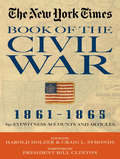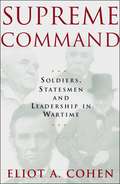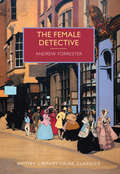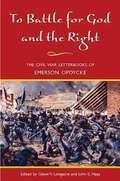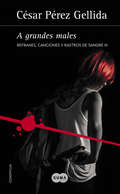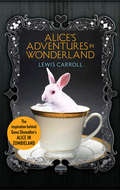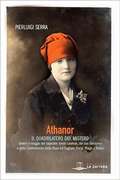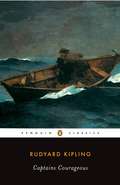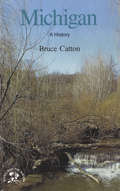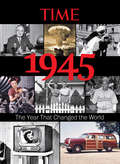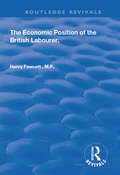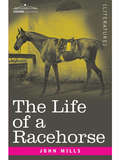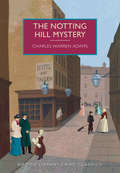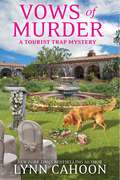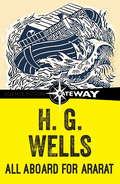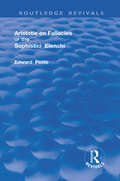- Table View
- List View
New York Times Book of the Civil War 1861-1865: 650 Eyewitness Accounts and Articles
by Harold Holzer President Bill Clinton Craig SymondsThe Civil War as you've never experienced it before, through original, first-hand reportage of The New York Times, the country's newspaper of record.The New York Times, established in 1851, was one of the few newspapers with correspondents on the front lines throughout the Civil War. The Complete Civil War collects articles written about the war from 1861 to 1865, plus select pieces before and after the war and is filled with the action, politics, and personal stories of this monumental event. From the first shot fired at Fort Sumter to the surrender at Appomattox, and from the Battle of Antietam to the Battle of Atlanta, as well as articles on slavery, states rights, the role of women, and profiles of noted heroes such as Ulysses S. Grant and Robert E. Lee, the era comes alive through these daily first-hand accounts. More than 600 of the most crucial and interesting articles from the war?typeset and designed for easy reading?have been hand-selected by editors and Civil War scholars Harold Holzer and Craig Symonds who also provide commentary throughout the book. Illustrated with hundreds of maps, historical photographs, and engravings, this book is a treasure for Civil War and history buffs everywhere."This is a fascinating and riveting look at the most important event in American history as seen through the eyes of an institution that was emerging as the most important newspaper in American history. In these pages, the Civil War seems new and fresh, unfolding day after anxious day, as the fate of the republic hangs in the balance." Ken Burns"Serious historians and casual readers alike will find this extraordinary collection of 600 articles and editorials about the Civil War published in The New York Times before and during the war of great value and interest...enough to keep the most assiduous student busy for the next four years of the war's sesquicentennial observations." James McPherson"This fascinating work catapults readers back in time, allowing us to live through the Civil War as daily readers of The New York Times, worrying about the outcome of battles, wondering about our generals, debating what to do about slavery, hearing the words that Lincoln spoke, feeling passionate about our politics. Symonds and Holzer have found an ingenious new way to experience the most dramatic event in our nation's history." Doris Kearns Goodwin"Harold Holzer and Craig Symonds have included not only every pertinent article from the pages of The Times, but enhanced and illuminated them with editorial commentary that adds context and perspective, making the articles more informative and useful here than they were in the original issues. Nowhere else can readers of today get such an understanding of how readers of 1861-1865 learned of and understood their war." William C Davis
Supreme Command
by Eliot A CohenThe relationship between military leaders and political leaders has always been a complicated one, especially in times of war. When the chips are down, who should run the show -- the politicians or the generals? In Supreme Command, Eliot Cohen examines four great democratic war statesmen -- Abraham Lincoln, Georges Clemenceau, Winston Churchill, and David Ben-Gurion -- to reveal the surprising answer: the politicians. Great states-men do not turn their wars over to their generals, and then stay out of their way. Great statesmen make better generals of their generals. They question and drive their military men, and at key times they overrule their advice. The generals may think they know how to win, but the statesmen are the ones who see the big picture. Lincoln, Clemenceau, Churchill, and Ben-Gurion led four very different kinds of democracy, under the most difficult circumstances imaginable. They came from four very different backgrounds -- backwoods lawyer, dueling French doctor, rogue aristocrat, and impoverished Jewish socialist.Yet they faced similar challenges, not least the possibility that their conduct of the war could bring about their fall from power. Each exhibited mastery of detail and fascination with technology. All four were great learners, who studied war as if it were their own profession, and in many ways mastered it as well as did their generals. All found themselves locked in conflict with military men. All four triumphed. Military men often dismiss politicians as meddlers, doves, or naifs. Yet military men make mistakes. The art of a great leader is to push his subordinates to achieve great things. The lessons of the book apply not just to President Bush and other world leaders in the war on terrorism, but to anyone who faces extreme adversity at the head of a free organization -- including leaders and managers throughout the corporate world. The lessons of Supreme Command will be immediately apparent to all managers and leaders, as well as students of history.
Supreme Command: Soldiers, Statesmen and Leadership in Wartime
by Eliot A. CohenThe relationship between military leaders and political leaders has always been a complicated one, especially in times of war. When the chips are down, who should run the show -- the politicians or the generals? In Supreme Command, Eliot Cohen examines four great democratic war statesmen -- Abraham Lincoln, Georges Clemenceau, Winston Churchill, and David Ben-Gurion -- to reveal the surprising answer: the politicians. Great states-men do not turn their wars over to their generals, and then stay out of their way. Great statesmen make better generals of their generals. They question and drive their military men, and at key times they overrule their advice. The generals may think they know how to win, but the statesmen are the ones who see the big picture. Lincoln, Clemenceau, Churchill, and Ben-Gurion led four very different kinds of democracy, under the most difficult circumstances imaginable. They came from four very different backgrounds -- backwoods lawyer, dueling French doctor, rogue aristocrat, and impoverished Jewish socialist.Yet they faced similar challenges, not least the possibility that their conduct of the war could bring about their fall from power. Each exhibited mastery of detail and fascination with technology. All four were great learners, who studied war as if it were their own profession, and in many ways mastered it as well as did their generals. All found themselves locked in conflict with military men. All four triumphed. Military men often dismiss politicians as meddlers, doves, or naifs. Yet military men make mistakes. The art of a great leader is to push his subordinates to achieve great things. The lessons of the book apply not just to President Bush and other world leaders in the war on terrorism, but to anyone who faces extreme adversity at the head of a free organization -- including leaders and managers throughout the corporate world. The lessons of Supreme Command will be immediately apparent to all managers and leaders, as well as students of history.
The Female Detective: A British Library Crime Classic (British Library Crime Classics #0)
by Andrew ForresterThe Female Detective is the first novel in British fiction to feature a professional female detective. Written by Andrew Forrester, it was originally published in 1864. The protagonist is Miss Gladden, or 'G' as she is also known - the precursor to Miss Marple, Mma Ramotswe and Lisbeth Salander. Miss Gladden's deductive methods and energetic approach anticipate those of Arthur Conan Doyle’s Sherlock Holmes, and she can be seen as beginning a powerful tradition of female detectives in these seven short stories. 'G' uses similar methods to her male counterparts – she enters scenes of crime incognito, tracking down killers while trying to conceal her own tracks and her identity from others. 'G', the first female detective, does much physical detective work, examining crime scenes, looking for clues and employing all manner of skill, subterfuge, observation and charm solve crimes. Like Holmes, 'G' regards the regular constabulary with disdain. For all the intrigue and interest of the stories, little is ever revealed about 'G' herself, and her personal circumstances remain a mystery throughout. But it is her ability to apply her considerable energy and intelligence to solve crimes that is her greatest appeal, and the reappearance of the original lady detective will be welcomed by fans of crime fiction.
The Palliser Novels Volume One: Can You Forgive Her?, Phineas Finn, and The Eustace Diamonds (The Palliser Novels)
by Anthony TrollopeThree novels of propriety and politics in Victorian England—the basis for the BBC adaptation.Also known as the Parliamentary Novels, the first three books in Anthony Trollope&’s renowned series follow the lives of an aristocrat, his wife, and the political and social circles in which they move.Can You Forgive Her?: This revealing romp through proper society follows three different women who dare to defy Victorian standards.Phineas Finn: An adventurous Irishman sets out to find his fortune among proper English society—and winds up entering the world of Parliament.The Eustace Diamonds: An ambitious, keenly intelligent woman finds that lying is the easiest way to get through life.
To Battle for God and the Right: The Civil War Letterbooks of Emerson Opdycke
by Emerson Opdycke John Hass Glenn V. LongacreEmerson Opdycke, a lieutenant with the 41st Ohio Infantry and later a commander of the 125th Ohio Volunteer Infantry, won fame at the Battle of Franklin when his brigade saved the Union Army from defeat. He also played pivotal roles in some of the major battles of the western theater, including Chickamauga, Chattanooga, and Missionary Ridge. Opdycke's wartime letters to his wife, Lucy, offer the immediacy of the action as it unfolded and provide a glimpse into the day-to-day life of a soldier. Viewing the conflict with the South as a battle between the rights of states and loyalty to the Union, his letters reveal his dislike of slavery, devotion to the Union, disdain for military ineptitude, and opinions of combat strategies and high-ranking officers. A thorough introduction by editors Glenn V. Longacre and John E. Haas and a foreword by Peter Cozzens provide additional historical context and biographical information.
A grandes males (Refranes, canciones y rastros de sangre #3)
by César Pérez GellidaLos rastros de sangre concentran la acción al otro lado del Atlántico: Argentina es el escenario de este dantesco desenlace de la trilogía de César Pérez Gellida, un final que no dejará indiferente a ningún lector. Tercera y última entrega de la trilogía «Refranes, canciones y restos de sangre». Erika Lopategui y Ólafur Olafsson han llegado a Buenos Aires siguiendo el rastro de la única persona que puede ayudarlos a destapar la organización criminal que se esconde tras la Congregación de los Hombres Puros. Encontrar el Cartapacio de Minos, un misterioso documento que contiene la identidad de los integrantes de la cúpula de esta organización, es su única meta. Pero no solo ellos lo buscan... Pronto descubrirán que una cara conocida está más cerca de lo que a ellos les gustaría. A grandes males es un thriller donde la realidad y la ficción se confunden para sumergir allector en una trama cargada de incógnitas cuyas respuestas se encuentran entre los muros del edificio Barolo, un rascacielos levantado para albergar las cenizas de Dante Alighieri.
Alice's Adventures in Wonderland
by Lewis CarrollAlice is sitting on the edge of a riverbank when she spots a white rabbit in a waistcoat disappearing down a hole. Before long, she finds herself jumping down the rabbit-hole after it, and entering a world unlike any other. Here Alice drinks unknown liquids that shrink her in size and she eats mushrooms that make her gigantic. She encounters a caterpillar who smokes and a dormouse who scolds her, and she morphs into a seven-year-old Queen after winning a game of chess. Of all the daydreams documented in literary history, Alice's is the most outrageous, affecting, imaginative and powerful.
Alice's Adventures in Wonderland
by Lewis CarrollIt's been 150 years since Lewis Carroll penned Alice's Adventures in Wonderland, and Harlequin TEEN is celebrating this anniversary with a special new release of the beloved classic that inspired Gena Showalter's New York Times bestselling series The White Rabbit Chronicles. Don't miss this exclusive ebook edition, complete with a sneak peek at Alice in Zombieland.Imagine a fantastical place where rabbits wear pocket watches, hatters throw mad tea parties, cats give directions and nonsense abounds. Welcome to Wonderland, a world discovered by Alice when she tumbles down a rabbit hole on a hot summer day. Armed with courage and wit, Alice must solve countless riddles, argue with a caterpillar, play croquet with a queen and face all manner of unusual adventures in order to find her way home again.
Athanor El cuadrilatero del misterio
by Bruno Landis Pierluigi SerraEl omicidio del capitán Looman, en el puerto de Cagliari, es una de las piezas de un complicado mosaico que hace de escenario a la búsqueda de un misterioso objeto, físico o quizás no material, peleado por dos cofradías en lucha secular por su posesión. La búsqueda de los rastros del pasado, y el viaje entendido como camino no solamente material, se vuelven el "fil rouge" que une los acontecimientos narrados en esta novela histórica. Personajes contemporáneos y del pasado,en planos temporales separados y sin embargo misteriosamente conectados, se encuentran el las distintas etapas de un recorrido que presenta todas las características del camino iniciático. Una vía marcada en los ánimos y en los mapas de Europa, donde amor, caballería medieval, venganza y ocultismo juegan en el antiguo enígma escondido en el Libro del misterio.
Cabins in the Laurel
by Muriel Earley SheppardIn 1928 New York native Muriel Earley Sheppard moved with her mining engineer husband to the Toe River Valley -- an isolated pocket in North Carolina between the Blue Ridge and Iron Mountains. Sheppard began visiting her neighbors and forming friendships in remote coves and rocky clearings, and in 1935 her account of life in the mountains -- Cabins in the Laurel -- was published. The book included 128 striking photographs by the well-known Chapel Hill photographer, Bayard Wootten, a frequent visitor to the area.The early reviews of Cabins in the Laurel were overwhelmingly positive, but the mountain people -- Sheppard's friends and subjects -- initially felt that she had portrayed them as too old-fashioned, even backward. As novelist John Ehle shows in his foreword, though, fifty years have made a huge difference, and the people of the Toe River Valley have been among its most affectionate readers.This new large-format edition, which makes use of many of Wootten's original negatives, will introduce Sheppard's words and Wootten's photography to a whole new generation of readers -- in the Valley and beyond.
Captains Courageous
by Rudyard KiplingYoung Harvey Cheyne is rich, spoiled, prejudiced, and totally lacking in the real experiences of life. When the fifteen-year-old is accidentally washed overboard a great ocean liner headed for Europe, he is picked up by a fisherman and brought aboard the fishing schooner We're Here. Harvey's stories of privilege and wealth mean nothing aboard this hard-working vessel, and the boy receives many lessons in self-reliance, values, and hard-bitten reality - "things every man must know, blind, drunk, or asleep" - in the words of Long Jack. Harvey, Long Jack, Tom Platt, Manuel, and many more great characters come alive in this rich retelling of life aboard the We're Here.
Dying to Read (A Survivors' Book Club Mystery)
by Lynn CahoonBookshop owner and cancer survivor Rarity Cole loves her life in Sedona, Arizona—the community of healing she&’s found; her adorable Yorkie, Killer; and the friends she&’s made in the survivors&’ book club. Now one of them needs her help because her husband&’s been accused of murder . . . When her week begins, Rarity expects the biggest mystery she&’ll need to solve is how a rare first edition of Lewis Carroll&’s Alice in Wonderland ended up in her bookstore bathroom. But after book club member Shirley tells her that her husband George, who has dementia, is the prime suspect in a nursing home murder, Rarity feels as if she&’s stepped through the looking glass. As someone who&’s been given a second chance at life, Rarity wishes her friend Shirley a second chance at love. But Shirley has rebuffed her senior suitor Terrance out of loyalty to George, even though he no longer knows who she is. Except guess who&’s the second suspect? Shirley&’s caught between two men—and it&’s up to Rarity and the survivor sleuths to determine if one of them is capable of cold-blooded murder . . .
Michigan: A Bicentennial History (States and the Nation)
by Bruce CattonThe late Pulitzer-Prize-winning historian Bruce Catton is known to millions of readers for his absorbing works on the Civil War. In this book, he turns to his native Michigan to tell a story of what happened when a primitive wilderness changed into a bustling industrial center so fast that it was as if the old French explorer Etienne Brule "should step up to shake hands with Henry Ford." The idea that abundance was "inexhaustible--that fatal Michigan word," as the author calls it--dominated thinking about the state from the days when Commandant Cadillac's soldiers arrived at Detroit until his name became a brand of car. Viewed in this light, Michigan is a case study of all America, and Americans in any state will be fascinated. In a colorful, dramatic past, Mr. Catton finds understanding of where we are in the present and what the future will make us face.
Pastoral Epistles, Volume 46 (Word Biblical Commentary)
by Bruce M. Metzger Ralph P. Martin Lynn Allan Losie David Allen Hubbard Glenn W. Barker John D. Watts James W. WattsThe Word Biblical Commentary delivers the best in biblical scholarship, from the leading scholars of our day who share a commitment to Scripture as divine revelation. This series emphasizes a thorough analysis of textual, linguistic, structural, and theological evidence. The result is judicious and balanced insight into the meanings of the text in the framework of biblical theology. These widely acclaimed commentaries serve as exceptional resources for the professional theologian and instructor, the seminary or university student, the working minister, and everyone concerned with building theological understanding from a solid base of biblical scholarship.Overview of Commentary OrganizationIntroduction—covers issues pertaining to the whole book, including context, date, authorship, composition, interpretive issues, purpose, and theology.Each section of the commentary includes:Pericope Bibliography—a helpful resource containing the most important works that pertain to each particular pericope.Translation—the author’s own translation of the biblical text, reflecting the end result of exegesis and attending to Hebrew and Greek idiomatic usage of words, phrases, and tenses, yet in reasonably good English.Notes—the author’s notes to the translation that address any textual variants, grammatical forms, syntactical constructions, basic meanings of words, and problems of translation.Form/Structure/Setting—a discussion of redaction, genre, sources, and tradition as they concern the origin of the pericope, its canonical form, and its relation to the biblical and extra-biblical contexts in order to illuminate the structure and character of the pericope. Rhetorical or compositional features important to understanding the passage are also introduced here.Comment—verse-by-verse interpretation of the text and dialogue with other interpreters, engaging with current opinion and scholarly research.Explanation—brings together all the results of the discussion in previous sections to expose the meaning and intention of the text at several levels: (1) within the context of the book itself; (2) its meaning in the OT or NT; (3) its place in the entire canon; (4) theological relevance to broader OT or NT issues.General Bibliography—occurring at the end of each volume, this extensive bibliographycontains all sources used anywhere in the commentary.
Reading Between the Lies (A Survivors' Book Club Mystery #4)
by Lynn CahoonBookshop owner Rarity Cole is living her best life after surviving cancer—hosting book clubs, classes, and parties at her store, The Next Chapter, and giving back to her community in Sedona, Arizona. But an awkward outing to an art gallery is about to add a dark slant to the picture . . .Rarity is grateful for many things and people in her new life, including her friend Shirley, who is helping to provide backpacks and supplies for kids going back to school. But Shirley needs a big favor. With her husband in a memory-care home, she wants to attend an art opening with a male friend but fears local gossip. She asks Rarity, her friend Sam, and their boyfriends to come along as cover. It would be fun if not for the fact that the two couples are barely speaking…The evening proceeds without any social disasters. But the gallery owner—who struck Rarity as more of a spoiled playboy—is later found dead with an arrow in his back. Any lingering tensions must be set aside so the amateur sleuths can find an archer who may have taken the idea of pointed criticism a bit too literally . . .
TIME 1945: The Year That Changed the World
by The Editors of TIMEIn the 12 months of 1945, the world was radically reshaped: both Hitler's Germany and imperial Japan fell to Allied armies, in scenes of death and destruction that still defy belief. A new world order began to emerge, as the U.S. and the U.S.S.R. began their long Cold War duel, the United Nations was founded, and Europe's colonial empires began to collapse. New technologies unleashed by the war-radar, computers, rockets and atomic power-began to revolutionize our lives. At home, millions flocked to new suburban homes, television began to replace radio, and returning vets sparked an era-defining "baby boom." Now TIME captures all these earth-shaking events in 1945: The Year That Changed the World. Join us as vintage photos, illuminating graphics and fascinating "then and now" stories recapture the sense of turmoil, hope and change that followed history's greatest conflict.
The Economic Position of the British Labourer: 1865 Edition (Routledge Revivals)
by Henry FawcettOriginally published in 1865, the following book is made up of a course of lectures, which the author delivered in the University of Cambridge in the Autumn of 1864. The book includes chapters on the land tenure of England, the causes which regulate wages, and trade unions and strikes.
The Internationalists: How a Radical Plan to Outlaw War Remade the World
by Scott J. Shapiro Oona A. HathawayA bold and provocative history of the men who fought to outlaw war and how an often overlooked treaty signed in 1928 was among the most transformative events in modern history.On a hot summer afternoon in 1928, the leaders of the world assembled in Paris to outlaw war. Within the year, the treaty signed that day, known as the Peace Pact, had been ratified by nearly every state in the world. War, for the first time in history, had become illegal the world over. But the promise of that summer day was fleeting. Within a decade of its signing, each state that had gathered in Paris to renounce war was at war. And in the century that followed, the Peace Pact was dismissed as an act of folly and an unmistakable failure. This book argues that that understanding is inaccurate, and that the Peace Pact ushered in a sustained march toward peace that lasts to this day. The Internationalists tells the story of the Peace Pact by placing it in the long history of international law from the seventeenth century through the present, tracing this rich history through a fascinating and diverse array of lawyers, politicians and intellectuals—Hugo Grotius, Nishi Amane, Salmon Levinson, James Shotwell, Sumner Welles, Carl Schmitt, Hersch Lauterpacht, and Sayyid Qutb. It tells of a centuries-long struggle of ideas over the role of war in a just world order. It details the brutal world of conflict the Peace Pact helped extinguish, and the subsequent era where tariffs and sanctions take the place of tanks and gunships. The Internationalists examines with renewed appreciation an international system that has outlawed wars of aggression and brought unprecedented stability to the world map. Accessible and gripping, this book will change the way we view the history of the twentieth century—and how we must work together to protect the global order the internationalists fought to make possible.
The Life of a Racehorse
by John MillsThe Life of a Racehorse is a fictional biography detailing the life of a British racehorse from the horse's point of view. This book was republished by Cosimo in 2015 in honor of American race horsing, which got a shot in the arms when American Pharaoh became the first horse to win the "Grand Slam" of American horse racing (the Triple Crown, for the first time since 1978, and the Breeders' Cup Classic.) In this book, the horse, Sheet Anchor, narrates his life, from his time as a colt, through his training and racing days, to his sale as a stud from Tattersall's and his retirement. The story is revealed through Sheet Anchor's experiences and the dialogue of the humans he interacts with, including trainers, grooms, jockeys, and his master, Sir Digby. The Life of a Racehorse was highlighted in a 2015 New York Times article bringing attention to the use of the riding crop; it was cited as one of the only references to how horses might feel about its use. As such, horse lovers and race enthusiasts alike can look to this book for better insight into how horse racing has developed over the ages.
The Notting Hill Mystery (British Library Crime Classics #0)
by Charles Warren AdamsThe Notting Hill Mystery was first published between 1862 and 1863 as an eight-part serial in the magazine Once a Week. Widely acknowledged as the first detective novel, the story is told by insurance investigator Ralph Henderson, who is building a case against the sinister Baron R––, who is suspected of murdering his wife. Henderson descends into a maze of intrigue including a diabolical mesmerist, kidnapping by gypsies, slow-poisoners, a rich uncle's will and three murders. Presented in the form of diary entries, letters, chemical analysis reports, interviews with witnesses and a crime scene map, the novel displays innovative techniques that would not become common features of detective fiction until the 1920s.
Trilogía «Refranes, canciones y rastros de sangre»: Contiene Sarna con gusto, Cuchillo de palo y A grandes males
by César Pérez GellidaEl presente pack de la segunda trilogía de César Pérez Gellida construye la historia posterior de tres de los grandes protagonistas de la primera: Ramiro Sancho, Erika Lopategui y Ólafur Olafsson. Tras concluir la persecución del psicópata Augusto Ledesma, el inspector Ramiro Sancho vuelve al trabajo y se enfrenta al terrible y cruel secuestro de una adolescente. Una batalla de la que saldrá damnificado y que lo llevará a apartarse del cuerpo y a llevar una aparente vida de devaneos y vicios para olvidar. Mientras, Erika y Ólafur, con su nuevo compañero redimido, Uriel, emprenden una persecución sin tregua a los miembros de la organización criminal llamada Congregación de los Hombres Puros. Pero no será fácil, necesitarán la ayuda de todos sus aliados, atravesarán el Atlántico e incluso algunos perderán la vida en el intento. El pack incluye: Sarna con gusto, Cuchillo de palo y A grandes males. La crítica ha dicho...«Con Sarna con gusto Pérez Gellida alcanza la madurez en una obra original y de sofisticada crueldad. Los fieles al género Gellida estamos de suerte.»Dolores Redondo «Una de las mejores novelas que he leído.»Juan Gómez Jurado «Un altísimo nivel literario secundado con un lenguaje exquisito y brillantísimos diálogos. Una novela plagada de dilemas morales esencialmente kafkianos y de decisiones que nadie desearíamos nunca tener que tomar.»Zenda «Una vez más, me quito el sombrero ante el maestro. Aunque parecía imposible, César se ha superado a sí mismo con una novela muy trabajada, de trama compleja pero al mismo tiempo muy entretenida e instructiva.»Blog Libros que hay que leer
Vows of Murder (A Tourist Trap Mystery)
by Lynn CahoonFans of female sleuth cozies will delight in New York Times bestselling author Lynn Cahoon&’s latest installment in her long-running Tourist Trap Mystery series. Jill&’s wedding to police chief Greg King is just days away, at a historic Spanish mission with a courtyard full of olive trees. But the folks in South Cove are more intrigued by what kind of ceremonies might be going on behind the walls of New Hope, the walled property where charismatic Kane Matthews and his followers reside. Jill isn&’t fond of the man, but his followers seem nice, and they buy a lot of books. After a distraught woman stops by at Coffee, Books, and More with a picture of her daughter, who she believes needs rescuing from the suspected cult—and then Matthews&’s body is found, at Jill&’s wedding venue of all places—Jill makes a commitment to solve the case. With Greg&’s mother as a houseguest, she must play hostess to her future in-law while pursuing a murderous outlaw . . .Praise for Lynn Cahoon and the Tourist Trap Mysteries &“I love the author&’s style, which was warm and friendly . . . [A] wonderfully appealing series.&” —Dru&’s Book Musings &“Lynn Cahoon&’s popular Tourist Trap series is . . . one of my go-to cozy mystery series!&” —Hope By the Book
All Aboard for Ararat
by H.G. WellsA profound and witty Voltairian dialogue between a twentieth-century Noah and an Old Testament Deity, planning a new Ark in which the best of mankind may be rescued from the new flood of war and horror.
Aristotle on Fallacies; or The Sophistici Elenchi (Routledge Revivals)
by Edward PosteFirst published in 1866, Aristotle on fallacies; or the Sophistici Elenchi, Poste explains Aristotles explanation of the nature of fallacies, if not satisfactory, seems to be as compete and intelligible as any that has since been offered.
